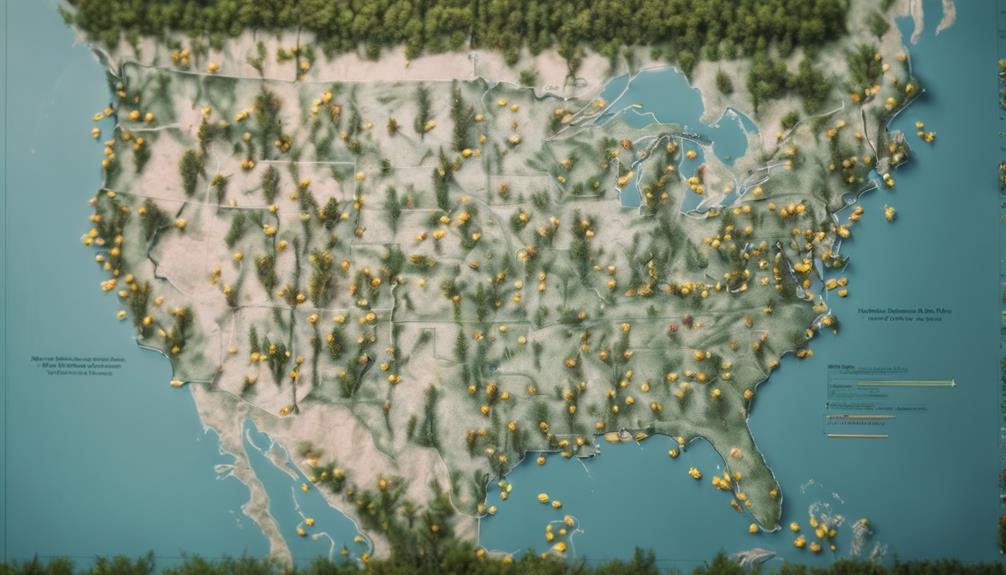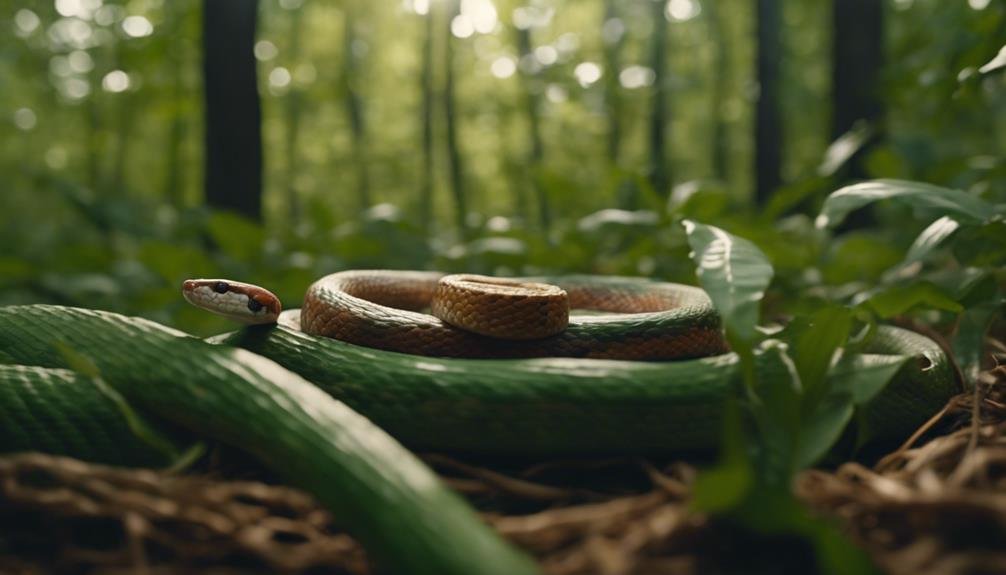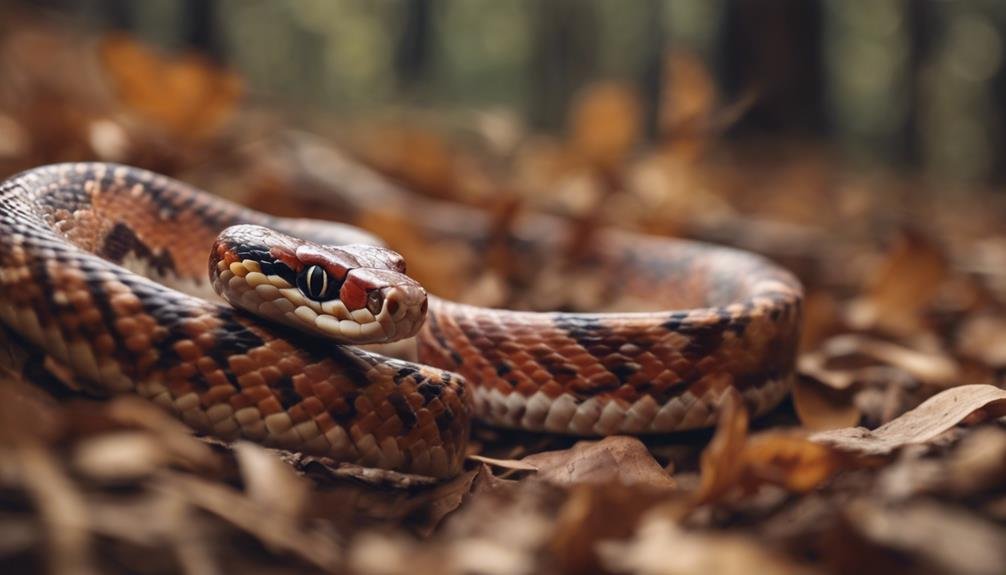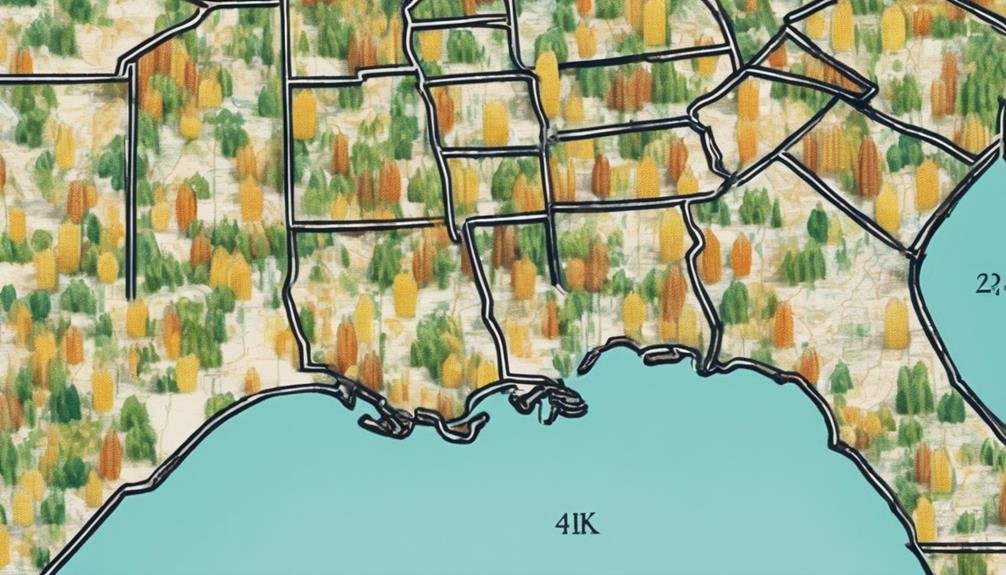You might be curious about where corn snakes are found, considering their reputation for adaptability and the broad range of habitats they occupy. Native to the Southeastern United States, these snakes make their homes in everything from meadowlands to the nooks of abandoned buildings. Their presence from southern New Jersey down to Florida and as far west as eastern Louisiana hints at a fascinating story of survival and adaptation. As you ponder their spread across such a varied landscape, consider the factors that drive their distribution and how these environments play a role in their life cycle. This opens up a world of discovery about these resilient creatures and the ecosystems they inhabit.
Key Takeaways
- Corn snakes are native to the Southeastern United States, from New Jersey to Florida and eastern Louisiana.
- They inhabit diverse environments, including meadowlands, sandy pine forests, and abandoned buildings.
- Their range has expanded globally, including states like Virginia, North Carolina, and parts of Kentucky.
- Conservation areas in Georgia protect them, indicating their presence and importance in the state.
- They have been observed in urban and wild settings, from overgrown fields to dense forests and rocky hillsides.
Native Range
Corn snakes, native to the Southeastern United States, thrive across a range spanning from southern New Jersey down to Florida and westward to eastern Louisiana. You’ll find these snakes making their home primarily in the Coastal Plain region, where they prefer upland terrestrial habitats like sandy pinewoods. This preference for specific environments doesn’t limit them to the wild; they’ve also adapted to suburban and agricultural areas, demonstrating a surprising tolerance to human disturbance.
As you explore the native range of corn snakes, it’s evident that their distribution isn’t uniform throughout. From North Carolina to the Florida Keys, these snakes show a patchy presence in the Piedmont and mountains, yet they remain most common in their favored Coastal Plain region.
Despite the challenges they face, corn snakes maintain a stable population status within their native range. This stability is partly thanks to specific safeguards in some states, like Georgia, where conservation efforts safeguard their survival. As a lover of these colorful and beneficial reptiles, you can take comfort in knowing that their presence in the Southeastern United States remains robust, thanks to a combination of natural resilience and targeted conservation actions.
Habitats and Environments
Exploring further, you’ll find that corn snakes adapt to a variety of habitats, from meadowlands to sandy pine forests, showcasing their versatility across the Southeastern U.S. These adaptable creatures thrive in southern New Jersey, Florida, Louisiana, and parts of Kentucky, making their home in a wide range of environments.
You’ll often find them nestled in wooded groves or basking in the sun-drenched scrub oak woods. Their ability to adapt is remarkable, allowing them to inhabit areas as diverse as rocky hillsides and lush woodlots. Even more fascinating is their penchant for taking refuge in abandoned buildings, a demonstration of their adaptability and resilience in the face of human encroachment.
Corn snakes aren’t just confined to the wild. In places like The Maryland Zoo, they’re featured in exhibits such as the Maryland Wilderness, where visitors can get a glimpse of their natural habitats. This not only draws attention to their presence in Maryland but also highlights their distribution across the Mid-Atlantic and Southeastern U.S., emphasizing their importance in the region’s biodiversity.
Geographic Distribution


You’ll find corn snakes mainly in the Southeastern United States, where they’ve carved out a range from southern New Jersey down to the Florida Keys, and as far west as parts of Louisiana and Kentucky. Their habitats vary widely, from meadowlands and wooded groves to sandy pine forests and abandoned structures.
This distribution not only highlights their adaptability but also sets the stage for understanding how their presence has expanded globally, beyond these common U.S. locations.
Native Habitat Range
Spanning from southern New Jersey down to Florida, and extending to parts of Louisiana, Kentucky, and even some Caribbean islands, the corn snake’s habitat is both diverse and widespread. You’ll find them throughout the Southeastern United States, thriving in a variety of environments.
These adaptable creatures make their homes in wooded groves, rocky hillsides, and lush meadowlands, as well as in woodlots and abandoned buildings. Their preferred habitats include regions rich in sandy pine, scrub oak woods, and tropical hammocks, areas that provide ample cover and food sources.
Corn snakes are most commonly seen in the Coastal Plain, where their patchy distribution reflects the varied landscape they inhabit. This broad range showcases their adaptability to different terrains and climates within their native range.
Global Presence Expansion
Over the years, corn snakes have expanded their geographic distribution beyond their native southeastern United States, adapting to a variety of global habitats. This expansion has seen them thrive in diverse environments from rocky hillsides and woodlots to tropical hammocks and abandoned buildings.
Their global presence signifies their adaptability to various climates and terrains, making them a common sight not just in their native Coastal Plain, but also in new, patchily distributed regions across the world. They’ve found homes in meadowlands and wooded groves, showcasing their ability to flourish in both natural and human-altered landscapes.
This remarkable expansion underlines the corn snake’s resilience and versatility, adapting to environments far from their original habitat.
Common US Locations
Corn snakes are often spotted throughout the southeastern United States, from the sandy shores of southern New Jersey down to the sun-drenched landscapes of Florida. They’ve made their homes in a variety of environments, adapting seamlessly to each unique habitat.
- New Jersey: Known for sandy pine forests where corn snakes thrive.
- Florida: Offers sun-drenched landscapes perfect for these reptiles.
- Louisiana & Kentucky: Their range extends to these areas, favoring wooded groves and scrub oak woods.
- Maryland: Not only do corn snakes reside here, but they’re also featured in educational programs, such as those at the Maryland Zoo’s Maryland Wilderness.
Corn snakes’ adaptability to environments ranging from sandy shores to wooded groves makes them fascinating subjects for educational programs across these states.
States With Populations


Several states, including New Jersey, Virginia, North Carolina, Florida, Louisiana, and parts of Kentucky, boast populations of corn snakes within their borders. You’ll find these colorful reptiles thriving across a varied landscape, from the dense forests of the Coastal Plain region to the rolling hills of the Piedmont and even into mountainous areas. Their adaptability allows them to flourish in both wild and modified environments, making them a common sight not just in undisturbed habitats but also in places marked by human disturbance.
In states like Florida and Louisiana, corn snakes are particularly abundant, basking in the warmth of the southern climate that spans from North Carolina to the Florida Keys and westward to eastern Louisiana and southern Tennessee. Despite the pressures of urban expansion and agricultural development, corn snakes show a remarkable resilience. However, it’s worth noting that in Georgia, efforts are specifically directed toward safeguarding these snakes, highlighting the importance of conservation work to guarantee their continued presence across these states. Their ability to adapt to a range of environments underscores the need to protect the diverse habitats they call home.
Urban and Wild Encounters
In both bustling cities and serene natural settings, you’re likely to encounter corn snakes, showcasing their incredible adaptability. These reptiles thrive across a variety of environments, from the heart of urban areas to the tranquility of the wild. Their presence is a proof of their versatility and the diverse American landscape they inhabit.
- Urban Areas: Corn snakes make themselves at home in abandoned buildings and navigate through suburban landscapes with ease.
- Wild Habitats: They’re frequently spotted in meadowlands, nestled in wooded groves, or slithering through sandy pine forests.
- Geographical Range: Their territory stretches from southern New Jersey down to Florida, and as far west as Louisiana and parts of Kentucky.
- Maryland’s Ecosystem: In Maryland, corn snakes are an integral part of the ecosystem. They’re even featured in educational programs at The Maryland Zoo, highlighting their significance.
- Natural Predators: Raptors, among other predators, play an important role in controlling the corn snake population, underlining the snake’s position within the ecosystem.
Corn snakes’ ability to adapt to both urban and natural environments showcases their resilience and the intricate balance of ecosystems they’re part of.
Conservation Status


You might wonder about the current state of Corn Snakes in the wild. While they’re not facing immediate danger, human activities like destroying their habitats pose real threats to their numbers.
Let’s take a closer look at the trends affecting their population, the risks they encounter, and the measures in place to protect them.
Current Population Trends
Corn snakes are currently classified as Least Concern on the IUCN Red List, reflecting their stable population status. You’ll find that their current population trends are encouraging, thanks to ongoing conservation efforts. These efforts aim to preserve their natural habitats, which are vital for their survival.
- Conservation efforts focus on preserving natural habitats.
- Human activities, like habitat destruction, pose a significant threat.
- They’re protected throughout Georgia, highlighting regional appreciation.
- Understanding these snakes contributes to their conservation.
- Stable population trends indicate successful conservation so far.
It’s clear that while they face threats from human activities, the collective understanding and appreciation of corn snakes have led to effective conservation efforts. Their status as Least Concern reflects a hopeful outlook, provided we continue to combat habitat destruction and maintain our efforts to protect their natural environments.
Threats and Protection Measures
Despite their stable population, corn snakes often face threats from habitat loss and are sometimes killed due to being mistaken for venomous species. They’re listed as a special concern in Florida, highlighting the impact of habitat loss and mistaken identity.
In Georgia and Maryland, they’re protected by law, making it illegal to collect them without permits. This requirement aims to curb accidental killings and guarantee their conservation. Efforts to preserve their natural habitats are essential for maintaining their stable population status.
The threat of being confused with venomous copperheads leads to unnecessary deaths, underscoring the importance of public education in conservation efforts. By requiring permits for possession, breeding, and sale, authorities are taking steps to protect these non-venomous snakes and support the preservation of their habitats.
Observed Locations
Across the Southeastern United States, from southern New Jersey to the Florida Keys, and west to Louisiana and parts of Kentucky, corn snakes have made a diverse range of habitats their home. You’ll find them thriving in environments from the dense forests of the Mid-Atlantic to the sandy shores of the Southeastern U.S. Their adaptability guarantees that populations remain locally common and stable, despite the variety of landscapes they inhabit.
Specifically, corn snakes are observed in:
- Overgrown fields, where they can hide and hunt.
- Dense forests, offering shelter and abundant prey.
- Abandoned buildings, which provide perfect hiding spots.
- Rocky hillsides, where they can bask and find cover.
- Tropical hammocks in regions like the Florida Keys, adding a unique element to their habitat range.
In Maryland, particularly in the Maryland Wilderness at The Maryland Zoo, corn snakes are just one of the 27 snake species you can encounter. This highlights not only their adaptability but also their significant presence across a wide geographical area. Whether nestled in the overgrown fields or exploring the rocky hillsides, corn snakes exemplify nature’s resilience and versatility.
Adaptations to Regions


To thrive in their diverse habitats, from meadowlands to sandy pine forests, corn snakes have developed remarkable adaptations. You’ll find them skillfully moving through trees in wooded groves or slithering under logs in humid, sandy forests. Their ability to adapt isn’t just limited to natural landscapes; corn snakes have made themselves at home in rocky areas, taking shelter under or within crevices that provide safety from predators and harsh weather.
In regions where human encroachment has altered the original landscapes, like suburban areas and agricultural lands, corn snakes have shown incredible versatility. They’ve learned to maneuver the challenges of these environments, finding refuge in abandoned buildings or utilizing the piles of debris and other man-made structures for protection and hunting. This adaptability extends to their diet and hunting methods, allowing them to thrive across a range of conditions from the tropical hammocks of Florida to the more temperate zones of the Mid-Atlantic.
Their presence in such varied environments highlights not just their adaptability but also the importance of preserving the diverse ecosystems that support them. Whether it’s the meadowlands, sandy forests, or the suburban outskirts, corn snakes have shown that with the right adaptations, they can call many places home.
Do Corn Snakes Found in Certain Regions Have Different Types of Teeth?
Yes, corn snake teeth explained. Corn snakes found in different regions do not have different types of teeth. All corn snakes have the same type of teeth, which are small, sharp, and curved backward to help them grasp and swallow their prey.
Relocation and Expansion
Corn snakes have ventured beyond their native boundaries, finding new homes in places like California and Oregon due to human intervention. This relocation and introduction to new areas have allowed corn snakes to expand their populations greatly. Their adaptability to various habitats plays an important role in their successful expansion. However, this isn’t without its downsides:
- Relocated: Corn snakes have been moved to areas outside their natural range, leading to new challenges in these ecosystems.
- Introduced: They’ve been introduced intentionally or accidentally by human activities.
- Expanded populations: Their numbers have increased in non-native regions, showcasing their adaptability.
- Invasive species: In some areas, they’ve become invasive, competing with native wildlife and posing a threat to biodiversity.
- Concerns: There are growing concerns about the potential impacts these snakes could have on local ecosystems.
The spread of corn snakes in areas they weren’t originally found has sparked efforts to monitor and manage their populations more closely. Efforts are ongoing to mitigate any negative effects and make sure that the balance of local ecosystems is maintained, addressing the concerns raised by their relocation and expansion.
Conclusion
To sum up, you’ll find corn snakes across the Southeastern United States, thriving in both bustling urban ruins and the tranquility of wild habitats. They’ve adapted to a range of environments, from sandy pine forests to meadowlands, marking their presence from New Jersey down to Florida and over to Louisiana.
Despite their broad spread, their conservation status needs attention. As they continue to adjust to expanding territories, including urban areas, their role in local ecosystems is ever-evolving, showcasing their remarkable adaptability.


